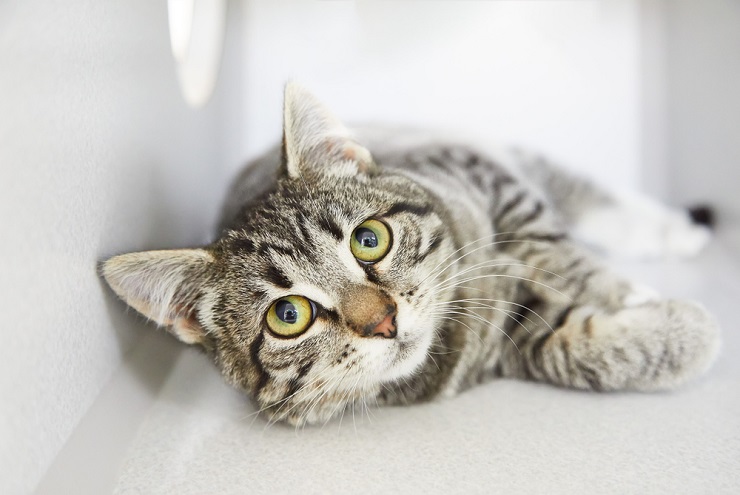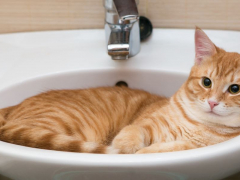
What Are Skin Lumps in Cats?
The term “skin lumps” (sometimes referred as Bumps) means any type of unusual swelling or other lesion on a cat’s skin. Normally, the skin should be smooth, flat, and free of irregularities. When a lump develops, it’s usually obvious to owners that there is something abnormal going on: the skin just does not look normal.
There are many different possible causes of dry or fluid-filled skin lumps, and the action that needs to be taken depends on the precise type of lump. Skin lumps are common, especially in older cats, and in some breeds of cat (e.g. Siamese)
What Causes Skin Lumps in Cats?
There is a long list of possible causes of swellings on cats’ skin. The following are the most common causes:
- Benign tumors, including basal cell tumors, cysts, lipomas (fatty tumors), hair follicle tumors, warts (papillomas) and others.
- Malignant tumors (or “cancerous tumors”) including mast cell tumor, squamous cell carcinoma, melanoma, hemangiosarcoma, fibrosarcoma, injection site sarcoma, mammary cancer, apocrine gland adenocarcinoma and lymphoma. There are many different types of cancer that can affect the skin.
- Abscesses, which often start from cat bites after fighting.
- Other causes including parasites (e.g. ticks or fleas), hematomas (blood blisters), and skin inflammation due to allergies.
Symptoms of Skin Lumps in Cats
The clinical signs of feline skin lumps are variable, but they include:
- A protruding mass or nodule, projecting outwards from the skin
- A soft or a hard swelling on the skin
- There may be multiple masses
- The surface of the mass may be haired or hairless. It’s common to have hair loss on the surface of skin lumps.
- There may or may not be itchiness
- The surface of the mass may look like normal skin, or may appear abnormal
- The may be pink, or may be pigmented
- There may or may not be ulceration, scabs, or an open discharging hole
- Different parts of the body may be affected: anywhere, from tip of the nose to the tip of the tail
Diagnosis of Skin Lumps

A part of the diagnosis process is a physical exam which involves your veterinarian checking your cat over carefully, including palpating your cat’s body, and feeling for any unusual lumps or bumps.
If you take your cat to your DVM veterinarian because they have a skin lump, the following steps may be taken. These steps are unlikely to be carried out all at once, at the time of the first visit.
They are generally carried out in a sequential way, using information gathered during each step to work out what may or may not need to be done next.
1. Detailed History Taking
Your vet will discuss every aspect of your cat’s condition and overall pet health care. This history will help to differentiate the various possible causes.
How old is your cat? Have there been lumps before? When did the lump appear? How rapidly has it been growing? Is it itchy? Has your cat been licking it? Has your cat been fighting? What is your cat’s vaccination status?
2. Physical Examination
A physical exam involves your veterinarian checking your cat over carefully, all over. This will include palpating your cat’s body, feeling for any unusual lumps or bumps, both internal and external.
Your cat’s superficial lymph nodes will be checked for any enlargement. Any abnormalities at all will be noted, and may be helpful towards making a diagnosis around the skin lump.
Sometimes this physical examination is sufficient to make an accurate diagnosis of the type of skin lump (e.g. a tick, an abscess, inflammatory skin disease, etc).
In other cases, some type of further investigation is needed to find out more about the details of the composition of the skin lump.
3. Fine Needle Aspirate and Other Biopsies

If an abnormal mass is found on the skin , a biopsy (sample of living tissue) is the only way that a definitive diagnosis can be made. This usually involve a Fine Needle Aspirate (FNA), which is the quickest, simplest, least invasive way of collecting a sample. This is a procedure that can often be carried out in a conscious cat, in the consulting room.
This involves pushing a fine needle into the lump, squirting the contents of the needle onto a glass microscope slide, and sending it to the laboratory for analysis.
Cytology will be carried out these fine needle aspiration samples, with a pathologist examining the samples, identifying the type of cell present on the slide, which will often lead to a diagnosis of the type of lump.
Sometimes, a second, larger, biopsy sample (e.g. a core biopsy, or an excisional biopsy, by excision of the entire lump) may be needed for a more accurate diagnosis by carrying out full histopathology, to discover more detailed information about the nature of the skin lump. This will usually require that the cat is admitted to the veterinary hospital, and general anesthesia is usually needed, as this is a type of surgical procedure.
4. Routine Blood and Urine Tests
As part of a general minimum database to assess cat health when working up a pet that has any type of ailment at all, vets often carry out routine blood work, including the usual panel of diagnostic tests, such as hematology (complete blood count) and biochemistry profiles.
Full urinalysis may also usually be undertaken.
These basic tests are a useful way of checking for any other underlying illnesses, and the results act as a useful baseline to monitor the future health of the cat, even if no immediate abnormality is found.
This background work up may or may not be done for your cat, depending on the details of the situation.
5. Specialized Blood Tests
Your veterinarian may recommend specific blood tests for some viral infections such as FeLV and FIV, since there are significant implications if your cat is positive for either of these.
6. Diagnostic Imaging
Radiography (x-rays) and abdominal ultrasound may be carried out, to examine your cat’s internal organs for possible spread of skin lumps, and to screen your cat for other internal diseases.
These investigations are not just important for making the initial diagnosis: they are also part of the staging process, searching for any evidence of metastases (spread of skin tumors to elsewhere in the body) which would help with decision making around treatment plans.
Treatment of Skin Lumps
Treatment options for skin lumps depend entirely on the diagnosis of the precise type of skin lump.
- Benign tumors may need no treatment at all: watchful monitoring may be all that’s needed, with surgical removal only necessary if the lump is growing bigger so that it is interfering with the cat or causing irritation in some way.
- Malignant tumors, including mast cell tumors, squamous cell carcinomas, melanomas, haemangiosarcomas generally need surgical removal, with margins of healthy tissue around the lump. Sometimes follow up treatment including chemotherapy or radiation therapy may be needed.
- Abscesses usually need to be opened, drained and flushed out, with antibiotic cover to ensure that any infection is fully resolved.
- Ticks need to be removed carefully so that no remnant of the tick’s head is left in place
- Hematomas (blood blisters) can be treated in the same way as benign skin tumors
- Skin inflammation may need anti-inflammatory medication as well as attempting to find, and remove, the primary cause of the inflammation.
Monitoring and Prognosis

Monitoring and prognosis depend on the type of skin lump, the location, and the overall underlying health of the patient.
Monitoring and prognosis depend on the type of skin lump, the location, and the overall underlying health of the patient. Cat owners should discuss this in detail with their DVM veterinarian.
Skin lumps can have a number of different origins, and if any cat owner is worried about any lump on their cat’s skin, they should talk to their local veterinarian about having a diagnosis made of the precise nature of the lump so that appropriate action can be taken.
Frequently Asked Questions
What causes lumps on a cat's skin?
There are many possible causes, from benign skin tumors to malignant skin tumors to inflammatory skin disease to parasites like ticks, as well as some others. If you are worried, you should take your cat to your veterinarian to be checked.
What do skin tumors look like on cats?
Skin tumors usually look like irregularities or swellings or protruberances on the surface of the skin.
Are lumps in cats always cancer?
Not at all. It can be impossible to identify cancer by just looking at a skin lump, and some sort of investigation is nearly always needed. If you are concerned, you should have the lump checked in person by your veterinarian.
How do you get rid of bumps on a cat?
The first stage is to have a proper diagnosis made about the nature of the lumps, by taking your cat to your veterinarian. Once a diagnosis has been made, a plan to resolve the bumps can be put in place.








My female American shorthair who’s 15 years old has a couple of lumps on the back part of her body. She’s had them for a few years and the one thing the vet said was that it’s better that they’re on the outside of her body and not growing inside. She’s had blood work and nothing showed up. She’s otherwise doing fine. The only thing is that they seem to maybe itch because she seems to really like when I scratch or comb her. I don’t worry too much because she’s fine and the lumps have been there for a few years.
It’s good that you have discussed these with your veterinarian, and I would continue to mention them to your vet at every routine check, so that you are absolutely certain that they are being carefully monitored. Benign small lumps are common in older cats.
Thanks. If you answer comments, I have a simple inquiry: my cat who’s been with me 12 of 14 years has what appears like an extra nipple behind her ear, (of course it isn’t a nipple, but now you know its size & texture, etc) which started growing after she had an eye removed. It has been an annoyance to her & she wants it gone. Therefore, so do I and I like a “nip it in the bud” approach.
Being less of a city physician type person and more of a country ranch type person, I’d like to cut it off myself & apply Wonder Dust to her skin afterwards to prevent regrowth of the lump. As for the “let’s just kill her off” – rifle approach, I’ll have her, rather, euthanized with 2 or more vials of euthanasia when it’s time for her to ascend & she’ll be cremated or buried, to wait for me in Heaven, rather than be eaten by some nasty Chinese or wolf, etc.
A small growth like that can often be left in an elderly animal, but if it is annoying her, then it would be best to have it surgically removed. But I would strongly recommend that you get this done by a veterinarian- it would not be fair to cut it off yourself as you suggest, and there would be many risks of complications (pain, bleeding, wound not healing etc). I hope this helps a bit.